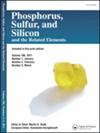Response surface analyzing the leaching process and crystallization process in the preparation of phosphate concentrate and Ca(H2PO4)2 ∙ H2O from phosphate tailing
IF 1.4
4区 化学
Q4 CHEMISTRY, INORGANIC & NUCLEAR
Phosphorus, Sulfur, and Silicon and the Related Elements
Pub Date : 2025-06-03
DOI:10.1080/10426507.2025.2507020
引用次数: 0
Abstract
Phosphate tailings, a solid waste generated during phosphate processing, pose environmental pollution risks. Phosphate concentrate and dicalcium phosphate monohydrate Ca(H2PO4)2 · H2O were successfully prepared from phosphate tailings through a selective leaching of dilute H3PO4 solution followed by evaporation, concentration, and cooling crystallization. The process conditions were optimized using the response surface methodology (RSM). Reaction temperature was identified as the most significant factor during acid leaching. Raising temperatures increased the phosphate grade of the residue. Leaching conditions were optimized as 16 P2O5 wt% H3PO4 concentration, 75 °C, and 30 min. Under these conditions, the P2O5 content of the concentrate reached 27.1%. During crystallization, the seed dosage was the key factor affecting the yield. Increasing the seed dosage significantly improved crystallization yield. Under optimal conditions, the yield of Ca(H2PO4)2 · H2O was 22.7%.
响应面分析了从磷酸尾矿中制备磷酸精矿和Ca(H2PO4)2∙H2O的浸出过程和结晶过程
磷酸盐尾矿是磷酸盐加工过程中产生的固体废物,具有环境污染风险。以磷酸尾矿为原料,经稀H3PO4溶液选择性浸出、蒸发、浓缩、冷却结晶,成功制备出磷酸精矿和一水磷酸二钙Ca(H2PO4)2·H2O。采用响应面法(RSM)对工艺条件进行优化。反应温度是酸浸过程中最重要的影响因素。升高温度提高了残渣的磷酸盐等级。优化的浸出条件为P2O5 wt% H3PO4浓度为16,75℃,30 min。在此条件下,精矿P2O5含量达到27.1%。结晶过程中,种子用量是影响产量的关键因素。增加种子投加量可显著提高结晶率。在最佳条件下,Ca(H2PO4)2·H2O的收率为22.7%。
本文章由计算机程序翻译,如有差异,请以英文原文为准。
求助全文
约1分钟内获得全文
求助全文
来源期刊
CiteScore
2.60
自引率
7.70%
发文量
103
审稿时长
2.1 months
期刊介绍:
Phosphorus, Sulfur, and Silicon and the Related Elements is a monthly publication intended to disseminate current trends and novel methods to those working in the broad and interdisciplinary field of heteroatom chemistry.

 求助内容:
求助内容: 应助结果提醒方式:
应助结果提醒方式:


